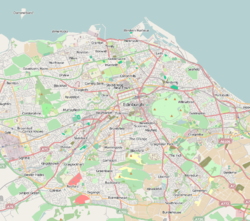Easter Road Stadium
| The Leith San Siro The Holy Ground |
|
|
Location in Edinburgh
|
|
| Location | Albion Road, Edinburgh |
|---|---|
| Coordinates | 55°57′42″N 3°9′56″W / 55.96167°N 3.16556°W |
| Owner | Hibernian F.C. |
| Capacity | 20,421 |
| Record attendance | 65,860 v Hearts 2 January 1950 |
| Surface | Desso GrassMaster |
| Construction | |
| Broke ground | 1892 |
| Opened | 1893 |
| Renovated | 2010 |
| Architect | Percy Johnson-Marshall (Famous Five and South Stands) |
| Tenants | |
| Hibernian F.C. Edinburgh Rugby |
1893–present 1998–1999 |
Easter Road is a football stadium located in the Leith area of Edinburgh, Scotland, which is the home ground of Scottish Championship club Hibernian (Hibs). The stadium currently has an all-seated capacity of 20,421, which makes it the fifth-largest football stadium in Scotland. Easter Road is also known by Hibs fans as "The Holy Ground" or "The Leith San Siro". The venue has also been used to stage international matches, Scottish League Cup semi-finals and was briefly the home ground of the Edinburgh professional rugby union team.
Hibs first played at the present site of Easter Road in 1893. The ground holds the record attendance for a Scottish match outside Glasgow, when 65,860 attended an Edinburgh derby on 2 January 1950. The size of the terracing was greatly reduced in the 1980s. After the publication of the Taylor Report, Hibs considered leaving Easter Road and moving to a different site (Straiton, near Loanhead was mooted), but these plans were abandoned in 1994. Redevelopment of the stadium began in 1995 and was completed in 2010. The Easter Road pitch had a pronounced slope until it was removed at the end of the 1999–00 season.
Hibernian played its first match on the Meadows, on 25 December 1875. The club first moved to the Easter Road area in 1880, to a ground known as Hibernian Park. This location had the advantage of being equidistant between their two main sources of support, the Irish immigrant communities in the port of Leith and the Old Town of Edinburgh. When Hibs suffered financial difficulties in the early 1890s, the lease on Hibernian Park expired and developers started building what would become Bothwell Street. The club was reformed in 1892 and a lease on a piece of land called Drum Park was secured. The site had restricted access from Easter Road, a pronounced slope and was in close proximity to Bank Park, the home of Leith Athletic. There was a sense of continuity from the previous ground, however, and the supporters were keen to get started again. The first match at Easter Road was played on 4 February 1893, a friendly against Clyde.
...
Wikipedia


